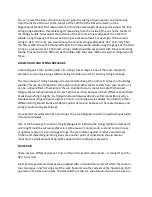
neck that has too much relief, for example, by generating a force in the neck opposite to that
caused by excessive string tension.
Fender also uses a unique bi-flex truss rod system on some instruments. Unlike standard truss
rods, which can only correct a neck that is too concave (under-bowed), the bi-flex truss rod can
compensate concave or convex (over-bowed) curvature by generating a correcting force in
either direction as needed.
First, check your tuning. Affix a capo at the first fret and depress the sixth string at the last fret.
With a feeler gauge, check the gap between the bottom of the string and the top of the 8th
fret—see the spec chart below for the proper gap.
Adjustment at headstock (allen wrench): Sight down the edge of the fingerboard from behind
the headstock, looking toward the body of the instrument. If the neck is too concave (action too
high), turn the truss rod nut clockwise to remove excess relief. If the neck is too convex (strings
too close to the fingerboard), turn the truss rod nut counter-clockwise to allow the string
tension to pull more relief into the neck. Check your tuning, then re-check the gap with the
feeler gauge and re-adjust as needed.
Adjustment at neck joint (phillips screwdriver): Sight down the edge of the fingerboard from
behind the body, looking up toward the headstock of the instrument. If the neck is too concave
(action too high), turn the truss rod nut clockwise to remove excess relief. If the neck is too
convex (strings too close to the fingerboard), turn the truss rod nut counter-clockwise to allow
the string tension to pull more relief into the neck. Check your tuning, then re-check the gap
with the feeler gauge and re-adjust as needed.
Note: In either case, if you meet excessive resistance when adjusting the truss rod, if your
instrument needs constant adjustment, if adjusting the truss rod has no effect on the neck, or if
you're simply not comfortable making this type of adjustment yourself, take your instrument to
your local Fender Authorized Dealer.
Neck Radius
7.25"
9.5" to 12"
15" to 17"
Relief
.012" (0.3 mm)
.010" (0.25 mm)
.008" (0.2 mm)
ACTION



























